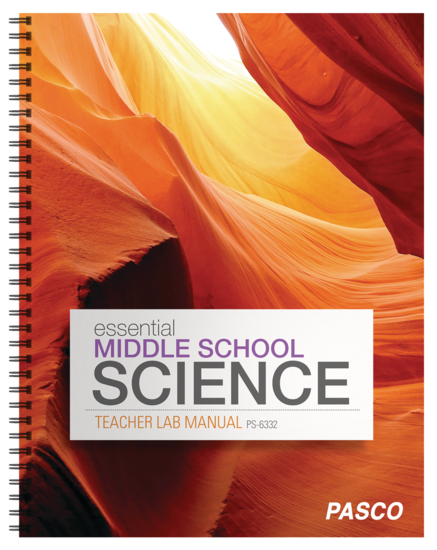Essential Middle School Science Teacher Lab Manual
The following list of activities are from PASCO's Essential Middle School Science Teacher Lab Manual, which covers physical, life, and environmental sciences. You may preview and download editable student handouts as well as the complete Teacher Lab Manual. Teacher resources files, including sample data and answer keys, can be accessed by signing in to or creating a PASCO account.
Grade Level: Middle School
Subject: Earth Science • Life Science • Physical Science
Teacher Collection Files
Sign In to your PASCO account to access teacher files and sample data.
Activities
01) Humidity and Dew Point
Students use a weather sensor to examine the differences between absolute and relative humidity and relate those to dew point.
02) Red Flags and Fire Weather Zones
Using a wireless weather sensor, students will identify the conditions that warrant a Red Flag Warning in their area and create a weather station to monitor those conditions.
03) Blockly Extension: Red Flag Warning
Using a wireless weather sensor and Blockly coding software, students will use real-time weather data to create a program that will alert the user to an active Red Flag Warning.
04) Family Preparedness Plan: Evacuation Map
Students will use a weather sensor with GPS to map out the perimeter of their school site and then identify evacuation routes as well as safe meeting areas.
05) Acid Rain and Weathering
Students will use a pH sensor and vinegar to model the effects of acid rain on various materials.
06) Night and Day
Students will be using different models to recreate the effects of the Sun on Earth. In Part 1, students use a simple model to examine night and day. In Part 2, students use a more accurate model to examine, predict, and describe seasons.
07) Seasons and Temperature
Students will use different models to recreate the effects of the Sun on Earth. In Part 1, students use a model to examine the equinox. In Part 2, students use a protractor to place the Earth model at a tilt and examine, predict, and describe temperature differences between seasons.
08) Photosynthesis
Guide students to measure the change in carbon dioxide (in a closed system) with a carbon dioxide sensor to facilitate an understanding of the relationship between carbon dioxide, respiration, and photosynthesis in plants.
09) Introduction to Acids and Bases
Students will use a pH sensor to determine the pH of common household substances.
10) Blockly Extension: pH
Students use a pH sensor and Blockly coding software to create a program that identifies acidic and basic solutions. Additionally, students are introduced and then asked to refer to steps of the Computational Thinking process as it relates to the tasks they are completing.
11) Chemical Reactions and Energy Transfer
Students use a temperature sensor, vinegar, sodium bicarbonate, and steel wool to investigate energy transfer during a chemical reaction.
12) Blockly Extension: Chemical Reactions and Energy Transfer
After students have completed the Chemical Reactions and Energy Transfer lab, they are now challenged to create a Blockly coding program that alerts the user to either a thermal energy release (exothermic) or thermal energy absorption (endothermic).
13) Thermoregulation
Students will explore the relationship between internal body temperature and the skin surface temperature of their hand under different conditions.
14) Describing Motion
Students will use a motion sensor to investigate how position, velocity, and acceleration may all be described and quantified when explaining motion.
15) Forces and Interactions
Students will investigate the relationship between force and acceleration. Newton's first law and and second law will also be explored.
16) Waves and Energy
Students learn that sound is produced by vibrating objects, that sound travels from a source through air, solids, and liquids, and its loudness depends on the amplitude of the wave. The amplitude of the wave defines the waves energy. The frequency of the wave defines the pitch.



